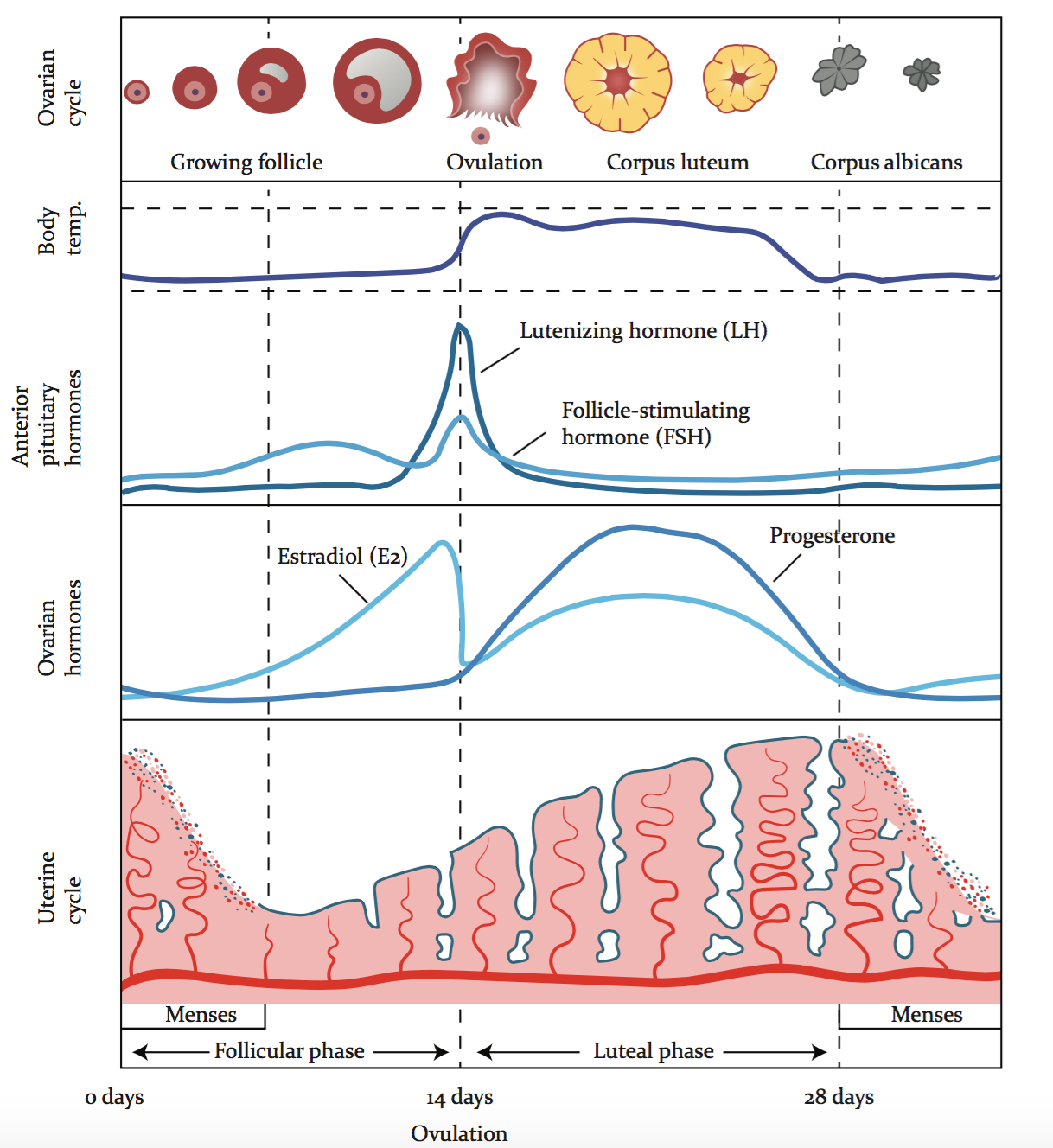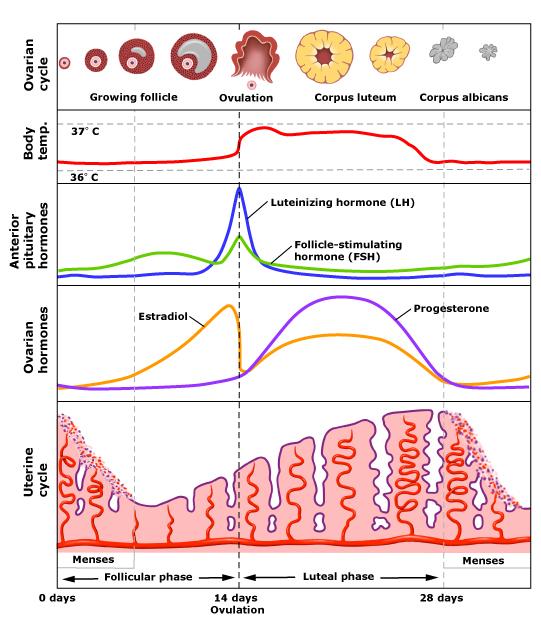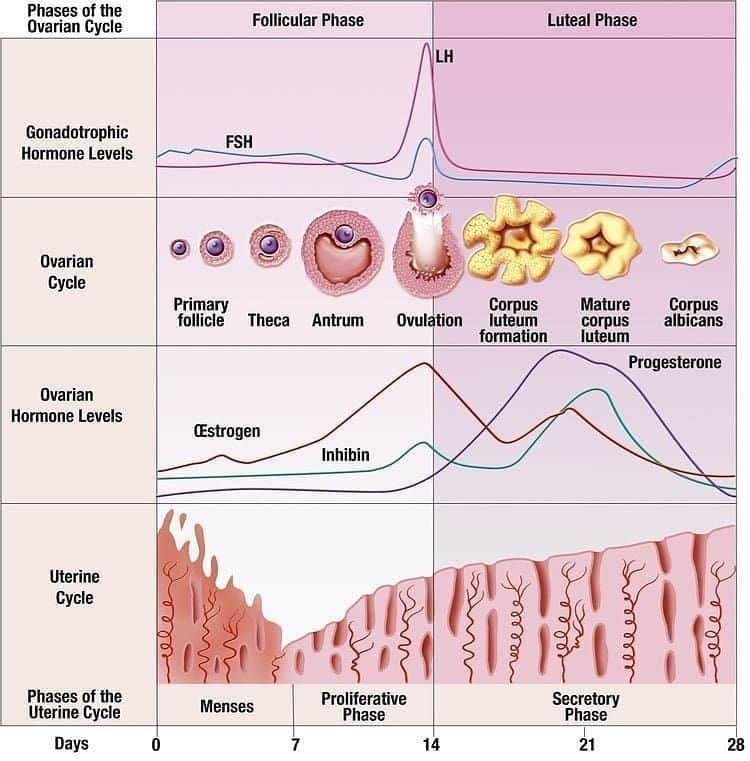Anovulatory Cycles And Short Luteal Phases
Only two-thirds of overtly normal menstrual cycles are ovulatory, that is, cycles in which ovulation occurs. The other third lack ovulation or have a short luteal phase in which progesterone production is insufficient for normal physiology and fertility. Cycles in which ovulation does not occur are common in girls who have just begun menstruating and in women around menopause. During the first two years following menarche, ovulation is absent in around half of cycles. Five years after menarche, ovulation occurs in around 75% of cycles and this reaches 80% in the following years. Anovulatory cycles are often overtly identical to normally ovulatory cycles. Any alteration to balance of hormones can lead to anovulation. Stress, anxiety and eating disorders can cause a fall in GnRH, and a disruption of the menstrual cycle. Chronic anovulation occurs in 615% of women during their reproductive years. Around menopause, hormone feedback dysregulation leads to anovulatory cycles. Although anovulation is not considered a disease, it can be a sign of an underlying condition such as polycystic ovary syndrome. Anovulatory cycles or short luteal phases are normal when women are under stress or athletes increasing the intensity of training. These changes are reversible as the stressors decrease or, in the case of the athlete, as she adapts to the training.
Phase : Luteal Phase:
When: The time after ovulation and before the start of menstruation. It normally lasts between 14 to 16 days.
What happens: The body prepares for a possible pregnancy.
Once ovulation occurs, the follicle that contained the egg transforms into a corpus luteum and begins to produce progesterone as well as oestrogen, with progesterone levels peaking about halfway through the luteal phase.
If an egg is fertilised, progesterone supports the early pregnancy, alternatively, the uterine lining starts to break down resulting in menstruation.
This is the phase of the menstrual cycle in which symptoms of PMS can occur. It is there advised to have good nutrition during the luteal phase to avoid it.
Plasma Phospholipids Were Significantly Reduced In The Luteal Phase
Of the 139 lipid species with detectable plasma levels, 57 reached statistical significance, , for 1 to 5 phase contrast comparisons: L-F, L-M, L-O, P-L and O-M . Thirty eight percent of the lipid species tested consistently showed a statistically significant decrease in the luteal phase relative to the follicular and in some cases, relative to the menstrual phase with 7 compounds showing a decrease in comparison to the premenstrual phase and 2 in comparison to the periovulatory phase. One compound, LPE 22:6, showed a statistically significant difference in 4 out of the 5 phase contrasts: L-F, L-M, L-O and P-L. After multiple testing, at q< 0.20, 17 lipid species met this threshold for L-F including 6 LPCs, 10 PCs and 1 LPE. One other LPC met this threshold for O-M .
Recommended Reading: How To Get More Melatonin
How Long Does A Menstrual Cycle Last
The average menstrual cycle is 28 days, but it can last anywhere between 21 and 45 days.
Irregular menstrual cycles are common too, especially if youre experiencing mental or physical stress, or significant fluctuations in weight. The body is clever it wont allow ovulation if its not ready for a pregnancy, says Dr Rosén.
But there are times when irregularities may suggest that something else is going on. If your cycle is suddenly shorter than 21 days, its worth considering that it might not be a menstrual bleed but something else, which could suggest an infection in the uterus or changes to the cervix, Dr Rosén explains.
Similarly, an ovarian cyst can affect the fine balance of all our hormones, and conditions like polycystic ovary syndrome can cause your cycle to last longer than 35 days.
Later in life, irregular cycles are also the first sign of decreasing fertility and the start of perimenopause.
When Are You Most Likely To Get Pregnant

Certain days of the month come with higher chances of conception.
Its possible to get pregnant at any point in the menstrual cycle.
Because sperm can survive up to five days inside the uterus, sex without birth control could lead to pregnancy at any time of the month, since regular cycles can shift unpredictably.
However, the general rule is that the highest chances of getting pregnant are during the days leading up to and including ovulation the fertile window. Tracking ovulation and the fertile window is especially important for people who are trying to get pregnant via in-vitro fertilization or who are treating infertility.
Also Check: How Long Do Hormone Replacement Pellets Last
How Long Is A Typical Menstrual Cycle
The typical menstrual cycle is 28 days long, but each woman is different.2 Also, a womans menstrual cycle length might be different from month-to-month. Your periods are still regular if they usually come every 24 to 38 days.3 This means that the time from the first day of your last period up to the start of your next period is at least 24 days but not more than 38 days.
Some womens periods are so regular that they can predict the day and time that their periods will start. Other women are regular but can only predict the start of their period within a few days.
The Menstrual Cycle Is Not Just A Period
The menstrual cycle is more than just the period. It is a chain of activities in the brain, ovaries, and uterus linked to hormones the chemical signals sent through the blood from one part of the body to another . The cycle is divided into two smaller cycles: the uterine cycle and the ovarian cycle .
Read Also: How Do I Balance My Hormones
When To See Your Doctor
Talk to your doctor if you are worried about your period.
For example, if:
- your period patterns change
- your periods are getting heavier
- your periods last more than eight days
- your periods come less than 21 days apart
- your periods come more than two to three months apart
- your symptoms are so painful they affect your daily activities
- you bleed between periods
- you bleed after sexual intercourse.
When Can You Have Sex
You can have sex whenever you want on any day of your menstrual cycle. The reproductive organs are more susceptible to infection during menstruation.
- Scheduling fewer activities during menstruation can help when your energy is low.
- Some people schedule trips and vacations around their cycle.
- Pap smears are most accurate if theyre performed when youre not on your period. Make sure to avoid douching, sexual intercourse, and using vaginal medications or hygiene products such as creams or gels for two days before the appointment.
- When estrogen levels are high , the body has its highest tolerance for pain, making this a good time to schedule appointments like waxing, getting a tattoo, or visiting the dentist.
Recommended Reading: What Do Female Hormone Pills Do
Understanding Your Menstrual Cycle
Women’s cycle lengths vary, and the most common cycle length is somewhere between 23 and 35 days. Any variation in menstrual cycle length that does occur is more likely to be during the part of the cycle before you ovulate . For most women, the length of time between ovulation and their monthly period is between 12 to 16 days .
How Menstruation Might Feel
Many people feel uncomfortable, tired, and have a negative mood during menstruation. Fortunately, there are lots of medicines and foods that can help with this.
Some people who have intense cramps during their period often use pain-relieving medication. Others apply heating pads on their lower back and abdomen to ease cramping pains.
Your period might last longer than average or be more intense. This is typically nothing to worry about, but its a good idea to talk to a health care provider about it to confirm that there arent any health issues affecting your periods. Dietary changes can help compensate for the loss of nutrients from heavy bleeding.
You May Like: Phexxi Hormone Free Birth Control
How The Follicular Phase Might Feel
Many people report a positive mood between days 6 and 14 of their cycle. For some, their confidence grows slightly between days 6 and 13 of their cycle due to increased estrogen and testosterone levels. If you notice this is true for you, you can plan your schedule so youre feeling your most confident during meetings or job interviews.
Hormone levels on days 614 of the cycle can affect the skins scent, which can affect how fragrances and perfumes interact with each persons personal chemistry.
How Do Period Problems Affect Pregnancy

Not all period problems affect pregnancy. But some period problems can be a cause of infertility. Infertility means you are unable to get pregnant after one year of trying .
- Irregular or missed periods may mean that you are not ovulating . Not ovulating is the most common cause of infertility in women.
- Painful, long, irregular, or heavy periods may be a sign that you could have problems getting pregnant. This depends on the cause of your period problem. For example, polycystic ovary syndrome is a common cause of heavy bleeding that affects fertility. Some women with uterine fibroids also have problems getting pregnant.
You May Like: What Does Testosterone Pills Do For You
How Many Women Have Irregular Cycles
Only 10 to 15% of women have cycles that are exactly 28 days, and in at least 14% to 25% of women, cycles are irregular.
Having an irregular cycle means that their cycle is either longer or shorter than the normal range of between 25 to 36 days.
Usually, cycles are the most irregular in the years immediately after a woman starts to menstruate and before menopause.
Role Of Hormones In Menstrual Cycle
The chemical messengers in our body called hormones, released by various endocrine glands are responsible for many changes in a human body. Menstruation is a slave to certain hormones. Every phase of the menstrual cycle is influenced by a female hormones namely estrogen, progesterone, FSH and LH. The variation in the level of each of these hormones decides the phase which a girl undergoes.
Lets have a look at the role of hormones in the menstrual cycle with the help of a diagram.
Follicle-stimulating hormone and luteinizing hormone are secreted by the anterior pituitary. FSH stimulates the growth of ovarian follicles that secrete estrogen. Progesterone is secreted by the corpus luteum.
Also Check:
We had an overview of the menstrual cycle. For detailed information, download BYJUS-The Learning App.
Recommended Reading: How To Naturally Fix Hormonal Imbalance
When Am I Most Fertile
During ovulation. The timing of this varies, but its usually 14 days before the first day of your period, says Dr Rosén.
Getting to know your body throughout the menstrual cycle can be helpful, especially if youre trying to conceive. Pay attention to your vaginal discharge, have a feel of your cervix and notice if your breasts are starting to feel tender, Dr Rosén adds. Youll get to know the signs.
Temperature During The Follicular Phase
Tracking your basal body temperature can help you figure out on which days of the month youll have the best odds of conceiving. Your basal body temperature is your lowest temperature when youre at rest.
To measure basal body temperature, keep a thermometer at your bedside and take your temperature upon waking, before you even get out of bed. This should be done at the same time each morning.
In the follicular phase of your cycle, your basal body temperature should be between 97.0 and 97.5°F . When you ovulate, your temperature will rise and remain higher during the luteal phase, confirming that the follicular phase is over.
Recommended Reading: How To Correct Hormonal Imbalance
The Menstrual Cycle Is Broken Into Phases
Both the uterine cycle and ovarian cycle are divided into different phases, in other words different stages . Different events occur during each phase. There are three phases in the uterine cycle: menstruation, proliferative phase, and secretory . There are also three phases in the ovarian cycle: follicular , ovulation , and luteal .
How Will My Menstrual Cycle Change Throughout My Life
From your first period…
The average age of getting your first period is just over 12 years, but this usually ranges from 9-15 years. It takes a while for your body to adjust and get the balance of all the hormones right, but after about a year, your periods should be regular, says Dr Rosén.
Through potential pregnancy and later life…
With the exception of pregnancies and breastfeeding, and occasional skipped periods if youre very stressed, your periods should continue regularly until youre in your mid-40s.
As we get older, the quality of our eggs declines, which is why the risk of miscarriage and chromosomal abnormalities increases. The corpus luteum also becomes less effective at producing progesterone, so your menstrual cycle might become shorter, says Dr Rosén. This is usually the very first sign of perimenopause.
Ending with perimenopause and menopause…
After a while, you start to run out of eggs, and you wont have your cycle every month. Despite not ovulating, your ovaries will still produce oestrogen, causing your uterus lining to grow. But as youre not ovulating, youre not producing progesterone and so eventually the lining becomes so heavy it just falls out.
Thats why you can get very irregular but heavy, long-lasting bleeds until around the age of 51. After this time, if you havent had a period in a year, then youre officially in menopause.
Don’t Miss: Hormonal Dark Spots On Face
What Happens During The Menstrual Cycle
To understand the menstrual cycle, it helps to know about the reproductive organs inside a woman’s body. These are:
- 2 ovaries where eggs are stored, developed and released
- the womb where a fertilised egg implants and a baby develops
- the fallopian tubes two thin tubes that connect the ovaries to the womb
The menstrual cycle is controlled by hormones. In each cycle, rising levels of the hormone oestrogen cause the ovary to develop and release an egg . The womb lining also starts to thicken.
In the second half of the cycle, the hormone progesterone helps the womb to prepare for implantation of a developing embryo.
The egg travels down the fallopian tubes. If pregnancy doesn’t occur, the egg is reabsorbed into the body. Levels of oestrogen and progesterone fall, and the womb lining comes away and leaves the body as a period .
The time from the release of an egg to the start of a period is around 10 to 16 days.
Watch an animation about how the menstrual cycle works.
What Hormones Are Involved In The Menstrual Cycle

The menstrual cycle is regulated by a number of different hormones. But the main ones are:
- Follicle-stimulating hormone : Stimulates egg development and the release of oestrogen.
- Luteinising hormone : Stimulates the release of the egg . Stimulates oestrogen and progesterone production.
- Oestrogen: causes growth of the uterine lining. Inhibits FSH. Stimulates the release of LH and hence release of the egg. Inhibits LH after ovulation.
- Progesterone: maintains the uterine lining. Inhibits LH after ovulation.
Don’t Miss: How To Lose Hormonal Belly Fat Naturally
Hormone Mapping: Unique Personalisation
The current practice of measuring female hormones is to take a single blood sample, usually on day three of the menstrual cycle when hormones are at their least active. This approach gives only a single day snapshot into a womans hormones which, given the high level of variability over a cycle, can make it very difficult to draw any firm conclusions.
Given that hormones have such a huge impact on womens lives, we felt more needed to be done. Working off general population averages and a single snapshot in time does not give women meaningful insights into their menstrual cycle and hormone health. This leaves women struggling for answers.
What is far more informative is knowing your own unique hormone variation over a complete menstrual cycle. By relating this information to how you feel during that cycle will provide powerful insights, giving women the answers they need.
This is exactly what MyFORM does, using a combination of blood analysis, artificial intelligence, and clinical expertise we have created a ground-breaking product for women.
We can mathematically model your own, personal hormone profile for each of the four key female hormones for each day of your menstrual cycle based on just 2 finger prick blood tests taken on day 14 and day 21 of your menstrual cycle.
The Other Shoe Drops: The Luteal Phase
After ovulation, the empty follicle that once contained the egg begins to secrete the hormone progesterone to thicken the lining of the uterus and prepare it for the possible implantation of an embryo.
As progesterone levels rise, you may begin to feel moodier. This happens because progesterone helps the body make cortisol, a hormone that tends to be higher in people who are stressed. If cortisol levels are already elevated because of outside factors, like a busy workweek, the progesterone can cause an excess of cortisol in the body. If Im already doing something to give myself high cortisol levels, by the time I get to the second half of my cycle, Im going to be irritable, Schwarzbein says.
The yucky feelings that come in the days before your period might have you looking for creature comforts to feel better. The same Journal of Consumer Psychology study found that women are more likely to eat high-calorie foods during the luteal phase of their cycle. We do find that women crave certain foods during this time, Dr. Banks says. However, everyone is a little different, and not everyone has the same symptoms.
TELL US: Do you notice a change in your moods from week to week? Share your experiences in the comments.
Don’t Miss: What Happens To Estrogen During Menopause